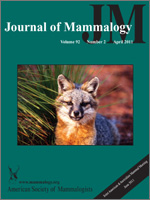The effects of forest fragmentation on individual space-use patterns were investigated in the European pine marten (Martes martes), considered as a forest-dependent species. The study was done in Ardennes, France, with the landscape consisting of both continuous forest and fragmented habitat, poor-quality habitat for pine martens. In this landscape context 3 predictions were tested: due to intraspecific competition, subadults should be overrepresented in fragmented habitat; according to the landscape supplementation theory, home ranges should be larger in fragmented habitat; and over seasons, home ranges should be more stable in forest than in fragmented habitat. Thirty-six individuals were trapped in both habitats, and 23 were radiotracked during 3–5 consecutive seasons. Confirming our 1st prediction, we found that the ratio of subadults to adults in fragmented habitat was higher than in forest. On the contrary, annual home ranges were larger in forest than in fragmented habitat, and temporal stability of home ranges was not significantly different between habitats. Therefore, our results indicate that the pine marten can persist in fragmented habitat and could rather be defined as a tree-dependent species.
How to translate text using browser tools
15 April 2011
Effect of forest fragmentation on space-use patterns in the European pine marten (Martes martes)
Marina Mergey,
Rémi Helder,
Jean-Jacques Roeder
ACCESS THE FULL ARTICLE

Journal of Mammalogy
Vol. 92 • No. 2
April 2011
Vol. 92 • No. 2
April 2011
forest fragmentation
habitat quality
home range
Martes
stability
supplementation theory




